ATMC - ICT700: Systems Analysis - OZES Analysis Report
VerifiedAdded on 2022/10/19
|16
|1499
|53
Report
AI Summary
This report provides a comprehensive analysis of the Australian Electric Supply (OZES) information system. It begins with a consultation section, exploring agile development methodologies such as Extreme Programming, Scrum, Feature-Driven Development, and Rational Unified Process, ultimately recommending the RUP approach for OZES. The analysis includes an information system event table, use case diagrams, use case descriptions, a domain model class diagram, and design class diagrams. A memo is also included, focusing on user-centered design and human-computer interaction principles, emphasizing the importance of user involvement and usability in developing a CRM application. The report concludes with a list of references.
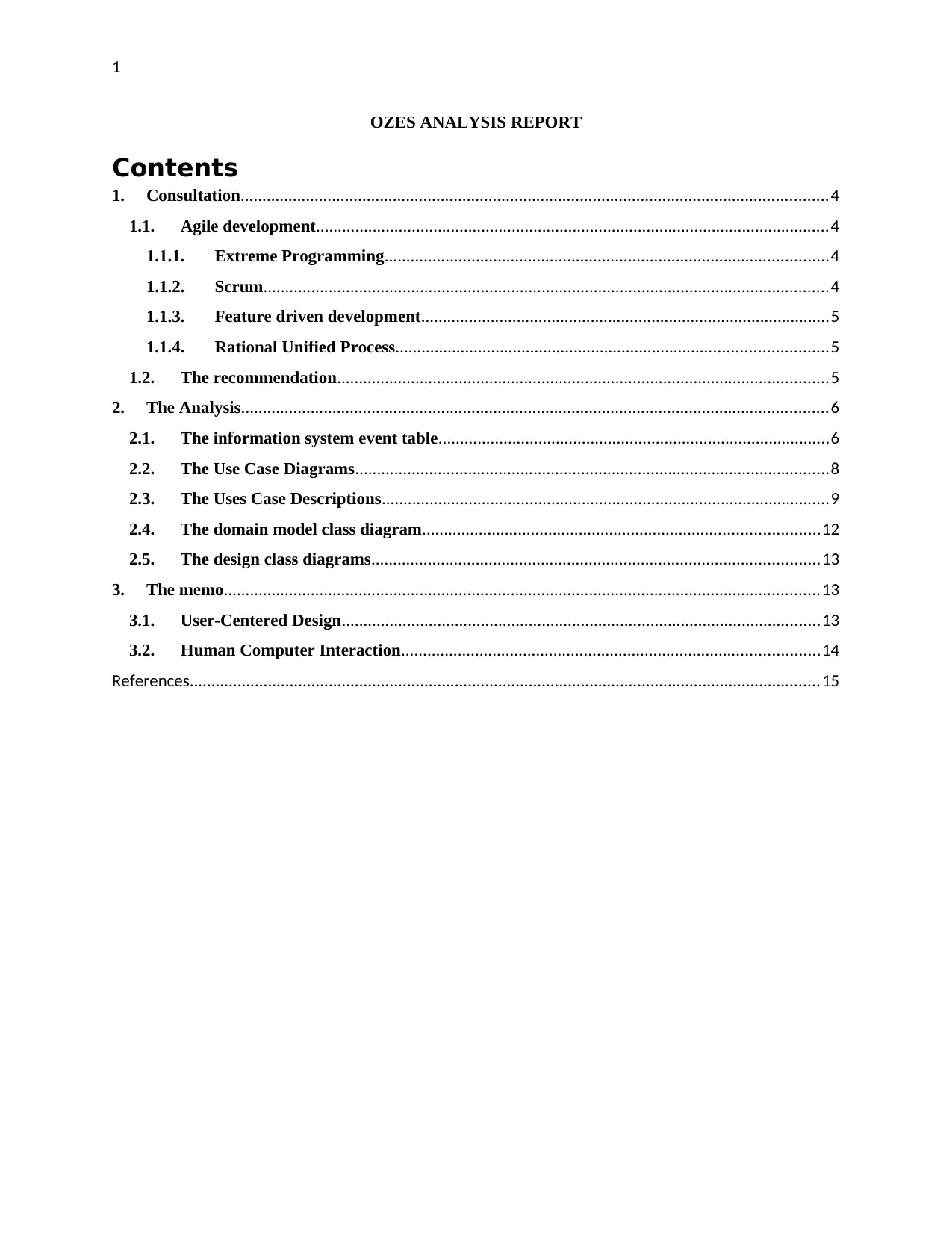
1
OZES ANALYSIS REPORT
Contents
1. Consultation.......................................................................................................................................4
1.1. Agile development......................................................................................................................4
1.1.1. Extreme Programming......................................................................................................4
1.1.2. Scrum..................................................................................................................................4
1.1.3. Feature driven development..............................................................................................5
1.1.4. Rational Unified Process...................................................................................................5
1.2. The recommendation.................................................................................................................5
2. The Analysis.......................................................................................................................................6
2.1. The information system event table..........................................................................................6
2.2. The Use Case Diagrams.............................................................................................................8
2.3. The Uses Case Descriptions.......................................................................................................9
2.4. The domain model class diagram...........................................................................................12
2.5. The design class diagrams.......................................................................................................13
3. The memo.........................................................................................................................................13
3.1. User-Centered Design..............................................................................................................13
3.2. Human Computer Interaction................................................................................................14
References.................................................................................................................................................15
OZES ANALYSIS REPORT
Contents
1. Consultation.......................................................................................................................................4
1.1. Agile development......................................................................................................................4
1.1.1. Extreme Programming......................................................................................................4
1.1.2. Scrum..................................................................................................................................4
1.1.3. Feature driven development..............................................................................................5
1.1.4. Rational Unified Process...................................................................................................5
1.2. The recommendation.................................................................................................................5
2. The Analysis.......................................................................................................................................6
2.1. The information system event table..........................................................................................6
2.2. The Use Case Diagrams.............................................................................................................8
2.3. The Uses Case Descriptions.......................................................................................................9
2.4. The domain model class diagram...........................................................................................12
2.5. The design class diagrams.......................................................................................................13
3. The memo.........................................................................................................................................13
3.1. User-Centered Design..............................................................................................................13
3.2. Human Computer Interaction................................................................................................14
References.................................................................................................................................................15
Paraphrase This Document
Need a fresh take? Get an instant paraphrase of this document with our AI Paraphraser
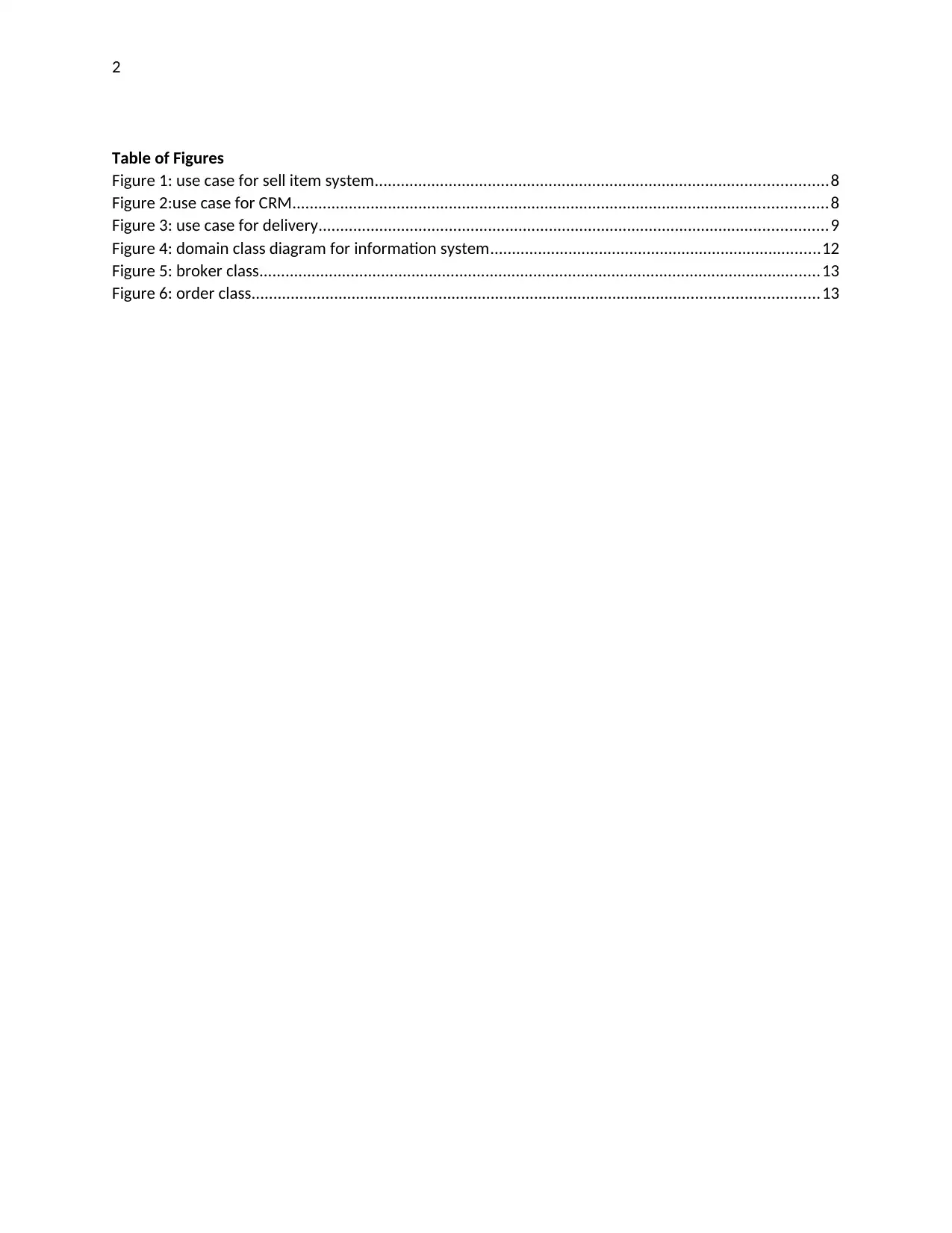
2
Table of Figures
Figure 1: use case for sell item system........................................................................................................8
Figure 2:use case for CRM...........................................................................................................................8
Figure 3: use case for delivery.....................................................................................................................9
Figure 4: domain class diagram for information system............................................................................12
Figure 5: broker class.................................................................................................................................13
Figure 6: order class..................................................................................................................................13
Table of Figures
Figure 1: use case for sell item system........................................................................................................8
Figure 2:use case for CRM...........................................................................................................................8
Figure 3: use case for delivery.....................................................................................................................9
Figure 4: domain class diagram for information system............................................................................12
Figure 5: broker class.................................................................................................................................13
Figure 6: order class..................................................................................................................................13

3
Table of Tables
Table 1: event table for the information system.........................................................................................6
Table 2: making and canceling order...........................................................................................................9
Table 3:posting items................................................................................................................................10
Table 4: generating report on sales...........................................................................................................10
Table 5: posting selling offers....................................................................................................................11
Table of Tables
Table 1: event table for the information system.........................................................................................6
Table 2: making and canceling order...........................................................................................................9
Table 3:posting items................................................................................................................................10
Table 4: generating report on sales...........................................................................................................10
Table 5: posting selling offers....................................................................................................................11
⊘ This is a preview!⊘
Do you want full access?
Subscribe today to unlock all pages.

Trusted by 1+ million students worldwide
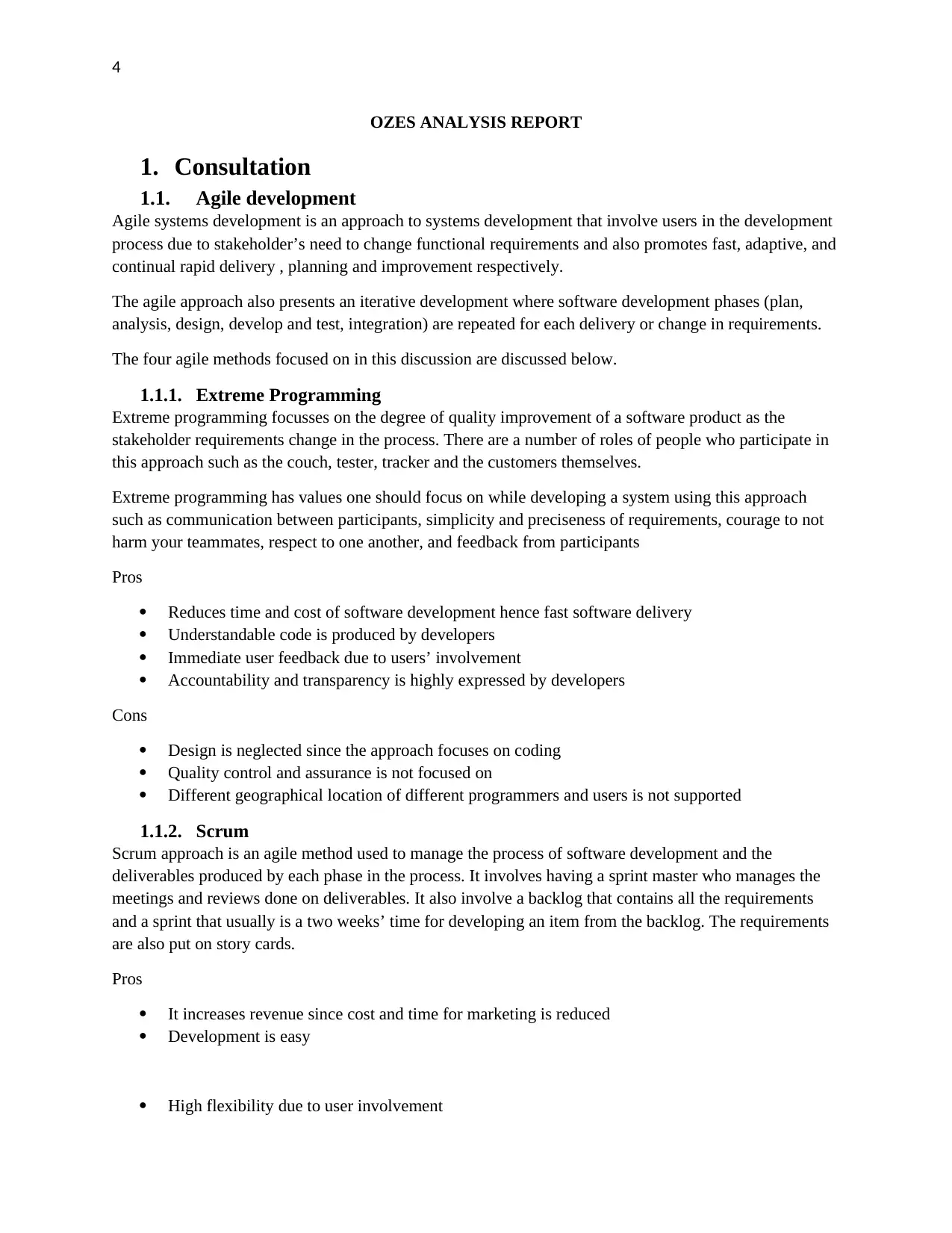
4
OZES ANALYSIS REPORT
1. Consultation
1.1. Agile development
Agile systems development is an approach to systems development that involve users in the development
process due to stakeholder’s need to change functional requirements and also promotes fast, adaptive, and
continual rapid delivery , planning and improvement respectively.
The agile approach also presents an iterative development where software development phases (plan,
analysis, design, develop and test, integration) are repeated for each delivery or change in requirements.
The four agile methods focused on in this discussion are discussed below.
1.1.1. Extreme Programming
Extreme programming focusses on the degree of quality improvement of a software product as the
stakeholder requirements change in the process. There are a number of roles of people who participate in
this approach such as the couch, tester, tracker and the customers themselves.
Extreme programming has values one should focus on while developing a system using this approach
such as communication between participants, simplicity and preciseness of requirements, courage to not
harm your teammates, respect to one another, and feedback from participants
Pros
Reduces time and cost of software development hence fast software delivery
Understandable code is produced by developers
Immediate user feedback due to users’ involvement
Accountability and transparency is highly expressed by developers
Cons
Design is neglected since the approach focuses on coding
Quality control and assurance is not focused on
Different geographical location of different programmers and users is not supported
1.1.2. Scrum
Scrum approach is an agile method used to manage the process of software development and the
deliverables produced by each phase in the process. It involves having a sprint master who manages the
meetings and reviews done on deliverables. It also involve a backlog that contains all the requirements
and a sprint that usually is a two weeks’ time for developing an item from the backlog. The requirements
are also put on story cards.
Pros
It increases revenue since cost and time for marketing is reduced
Development is easy
High flexibility due to user involvement
OZES ANALYSIS REPORT
1. Consultation
1.1. Agile development
Agile systems development is an approach to systems development that involve users in the development
process due to stakeholder’s need to change functional requirements and also promotes fast, adaptive, and
continual rapid delivery , planning and improvement respectively.
The agile approach also presents an iterative development where software development phases (plan,
analysis, design, develop and test, integration) are repeated for each delivery or change in requirements.
The four agile methods focused on in this discussion are discussed below.
1.1.1. Extreme Programming
Extreme programming focusses on the degree of quality improvement of a software product as the
stakeholder requirements change in the process. There are a number of roles of people who participate in
this approach such as the couch, tester, tracker and the customers themselves.
Extreme programming has values one should focus on while developing a system using this approach
such as communication between participants, simplicity and preciseness of requirements, courage to not
harm your teammates, respect to one another, and feedback from participants
Pros
Reduces time and cost of software development hence fast software delivery
Understandable code is produced by developers
Immediate user feedback due to users’ involvement
Accountability and transparency is highly expressed by developers
Cons
Design is neglected since the approach focuses on coding
Quality control and assurance is not focused on
Different geographical location of different programmers and users is not supported
1.1.2. Scrum
Scrum approach is an agile method used to manage the process of software development and the
deliverables produced by each phase in the process. It involves having a sprint master who manages the
meetings and reviews done on deliverables. It also involve a backlog that contains all the requirements
and a sprint that usually is a two weeks’ time for developing an item from the backlog. The requirements
are also put on story cards.
Pros
It increases revenue since cost and time for marketing is reduced
Development is easy
High flexibility due to user involvement
Paraphrase This Document
Need a fresh take? Get an instant paraphrase of this document with our AI Paraphraser
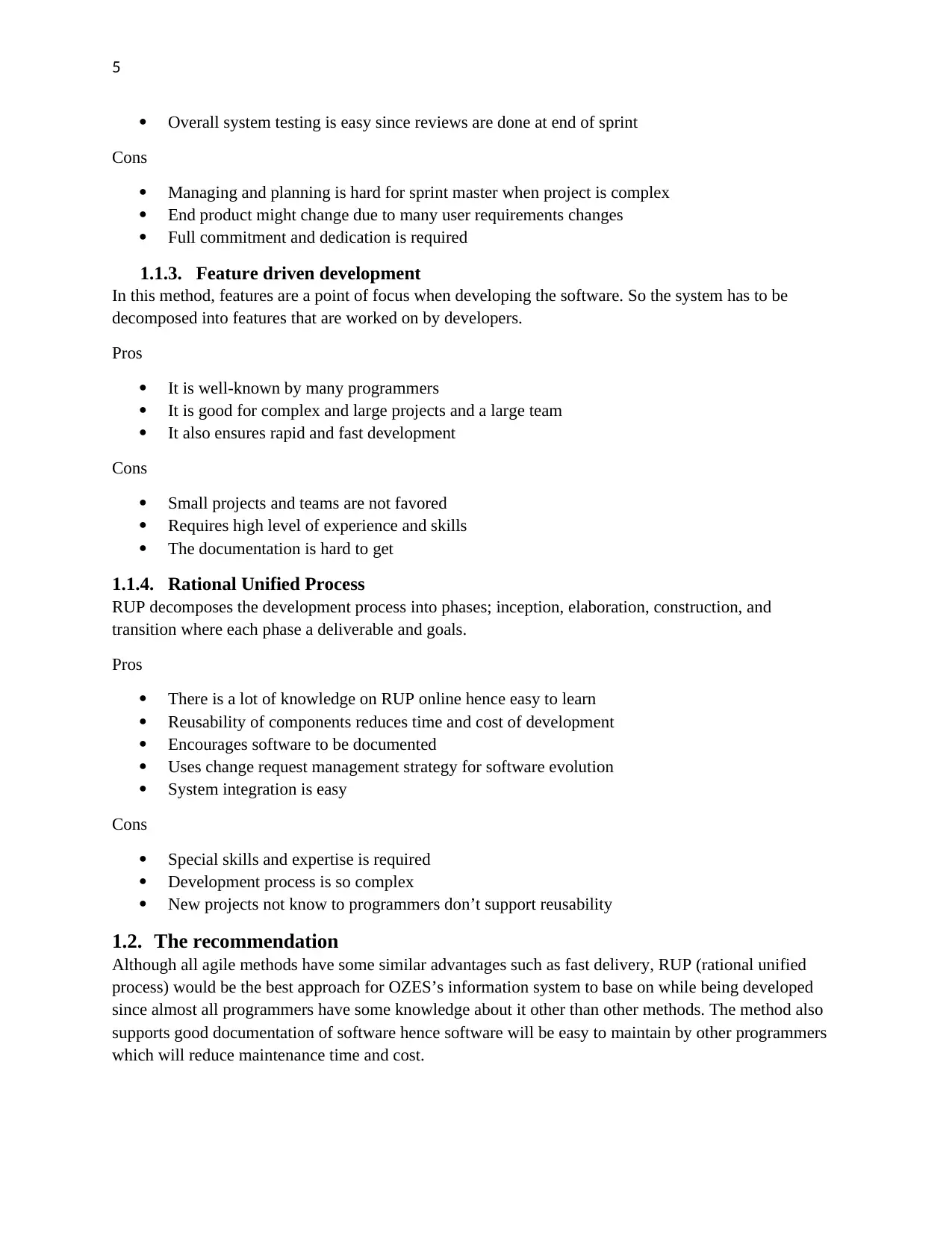
5
Overall system testing is easy since reviews are done at end of sprint
Cons
Managing and planning is hard for sprint master when project is complex
End product might change due to many user requirements changes
Full commitment and dedication is required
1.1.3. Feature driven development
In this method, features are a point of focus when developing the software. So the system has to be
decomposed into features that are worked on by developers.
Pros
It is well-known by many programmers
It is good for complex and large projects and a large team
It also ensures rapid and fast development
Cons
Small projects and teams are not favored
Requires high level of experience and skills
The documentation is hard to get
1.1.4. Rational Unified Process
RUP decomposes the development process into phases; inception, elaboration, construction, and
transition where each phase a deliverable and goals.
Pros
There is a lot of knowledge on RUP online hence easy to learn
Reusability of components reduces time and cost of development
Encourages software to be documented
Uses change request management strategy for software evolution
System integration is easy
Cons
Special skills and expertise is required
Development process is so complex
New projects not know to programmers don’t support reusability
1.2. The recommendation
Although all agile methods have some similar advantages such as fast delivery, RUP (rational unified
process) would be the best approach for OZES’s information system to base on while being developed
since almost all programmers have some knowledge about it other than other methods. The method also
supports good documentation of software hence software will be easy to maintain by other programmers
which will reduce maintenance time and cost.
Overall system testing is easy since reviews are done at end of sprint
Cons
Managing and planning is hard for sprint master when project is complex
End product might change due to many user requirements changes
Full commitment and dedication is required
1.1.3. Feature driven development
In this method, features are a point of focus when developing the software. So the system has to be
decomposed into features that are worked on by developers.
Pros
It is well-known by many programmers
It is good for complex and large projects and a large team
It also ensures rapid and fast development
Cons
Small projects and teams are not favored
Requires high level of experience and skills
The documentation is hard to get
1.1.4. Rational Unified Process
RUP decomposes the development process into phases; inception, elaboration, construction, and
transition where each phase a deliverable and goals.
Pros
There is a lot of knowledge on RUP online hence easy to learn
Reusability of components reduces time and cost of development
Encourages software to be documented
Uses change request management strategy for software evolution
System integration is easy
Cons
Special skills and expertise is required
Development process is so complex
New projects not know to programmers don’t support reusability
1.2. The recommendation
Although all agile methods have some similar advantages such as fast delivery, RUP (rational unified
process) would be the best approach for OZES’s information system to base on while being developed
since almost all programmers have some knowledge about it other than other methods. The method also
supports good documentation of software hence software will be easy to maintain by other programmers
which will reduce maintenance time and cost.
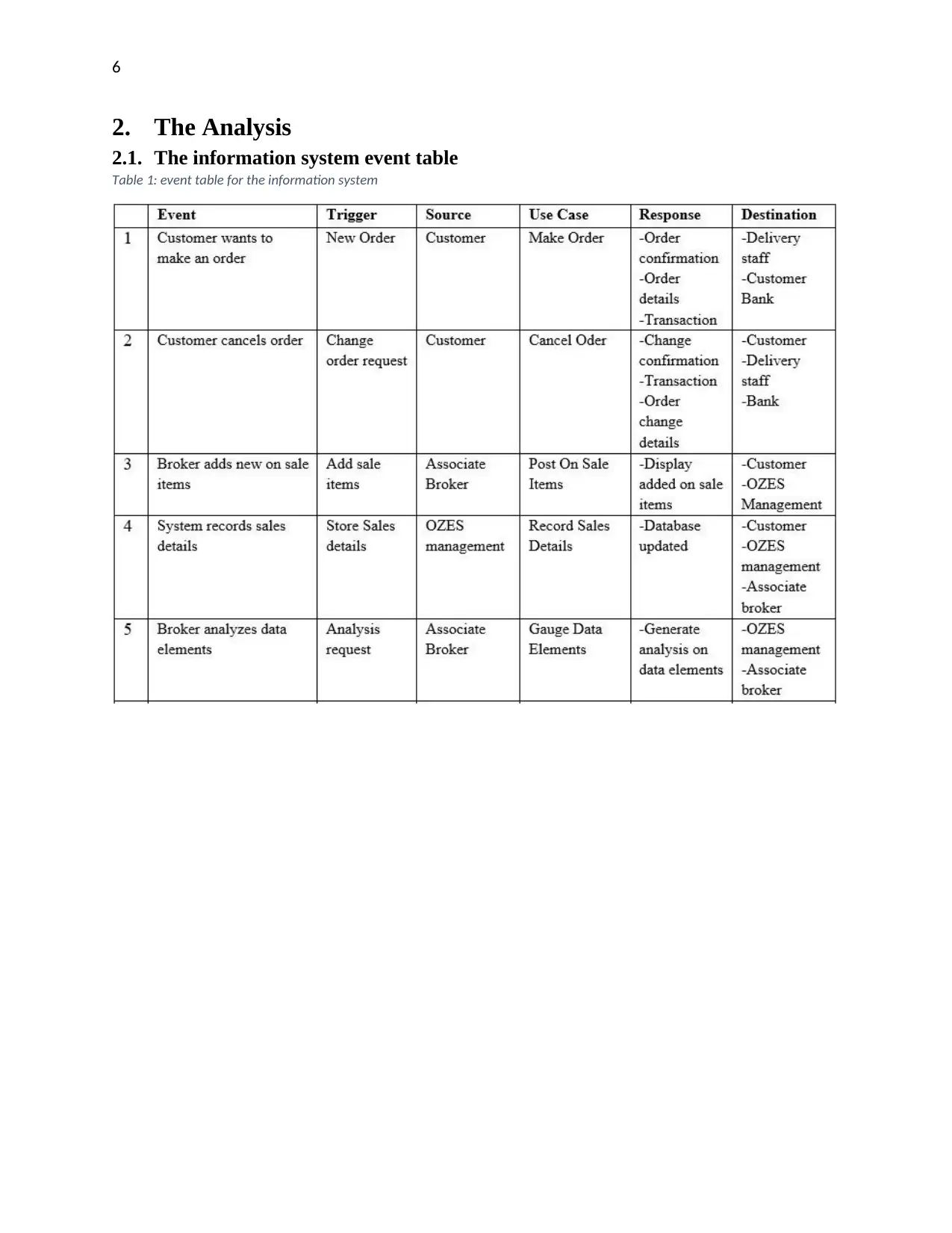
6
2. The Analysis
2.1. The information system event table
Table 1: event table for the information system
2. The Analysis
2.1. The information system event table
Table 1: event table for the information system
⊘ This is a preview!⊘
Do you want full access?
Subscribe today to unlock all pages.

Trusted by 1+ million students worldwide
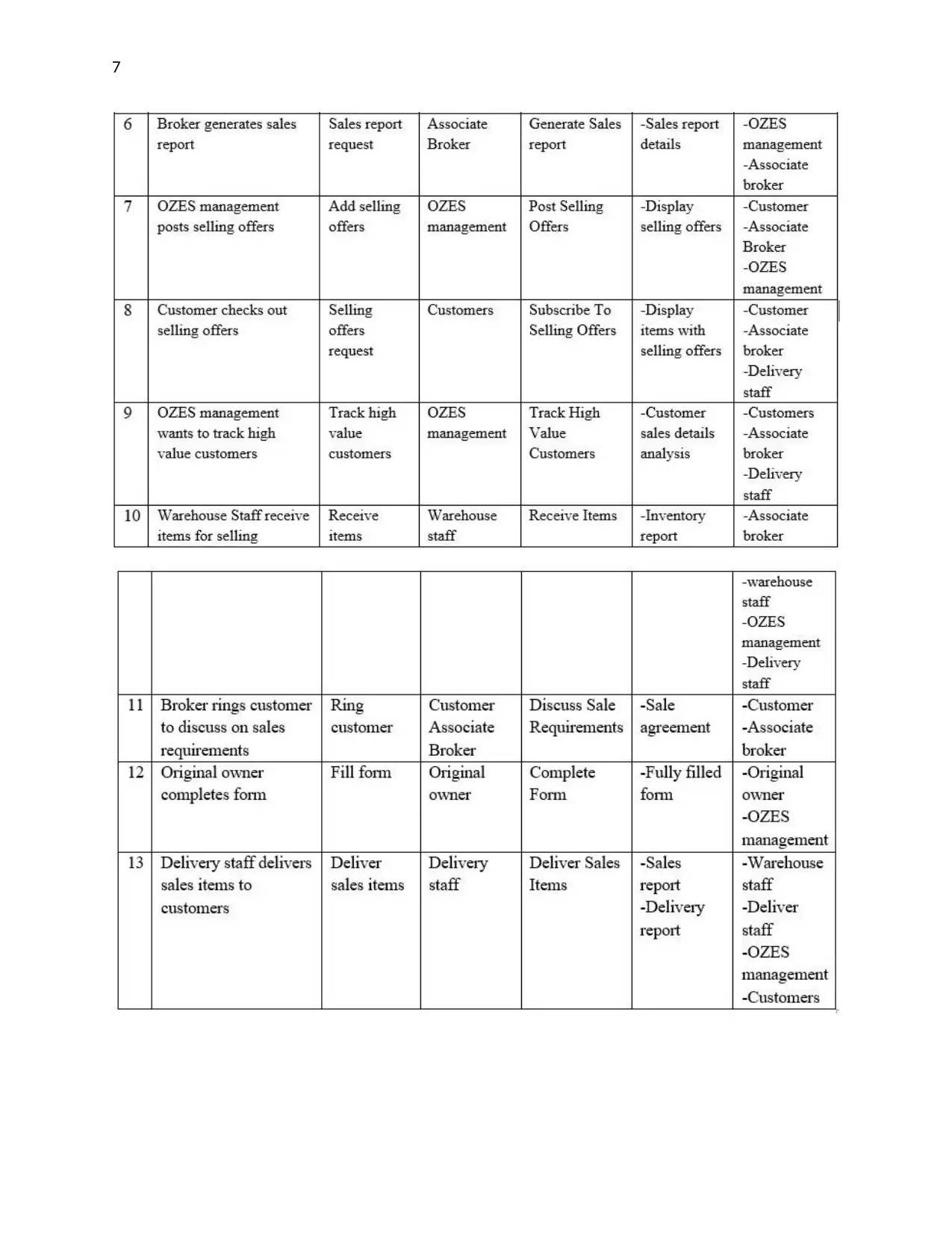
7
Paraphrase This Document
Need a fresh take? Get an instant paraphrase of this document with our AI Paraphraser
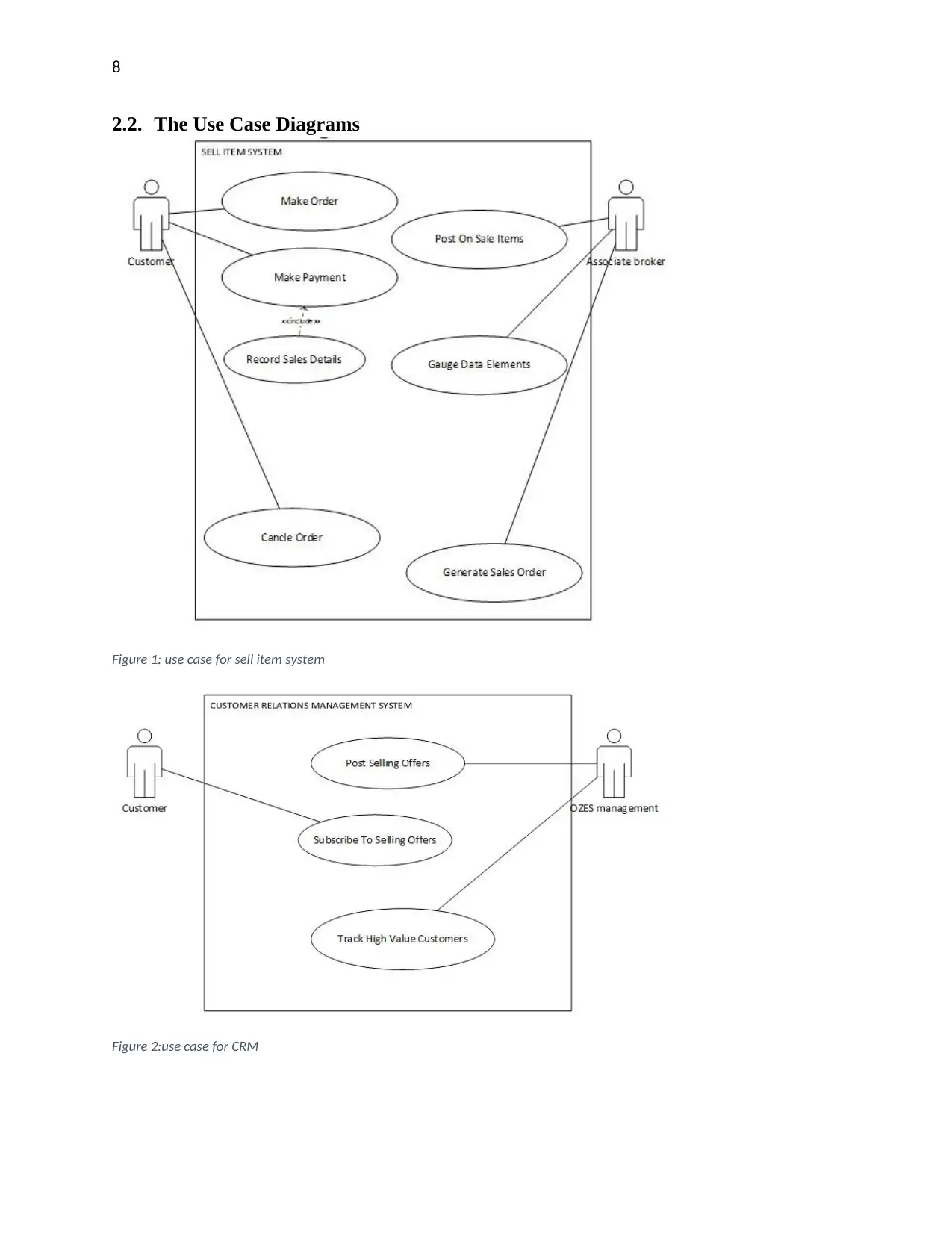
8
2.2. The Use Case Diagrams
Figure 1: use case for sell item system
Figure 2:use case for CRM
2.2. The Use Case Diagrams
Figure 1: use case for sell item system
Figure 2:use case for CRM
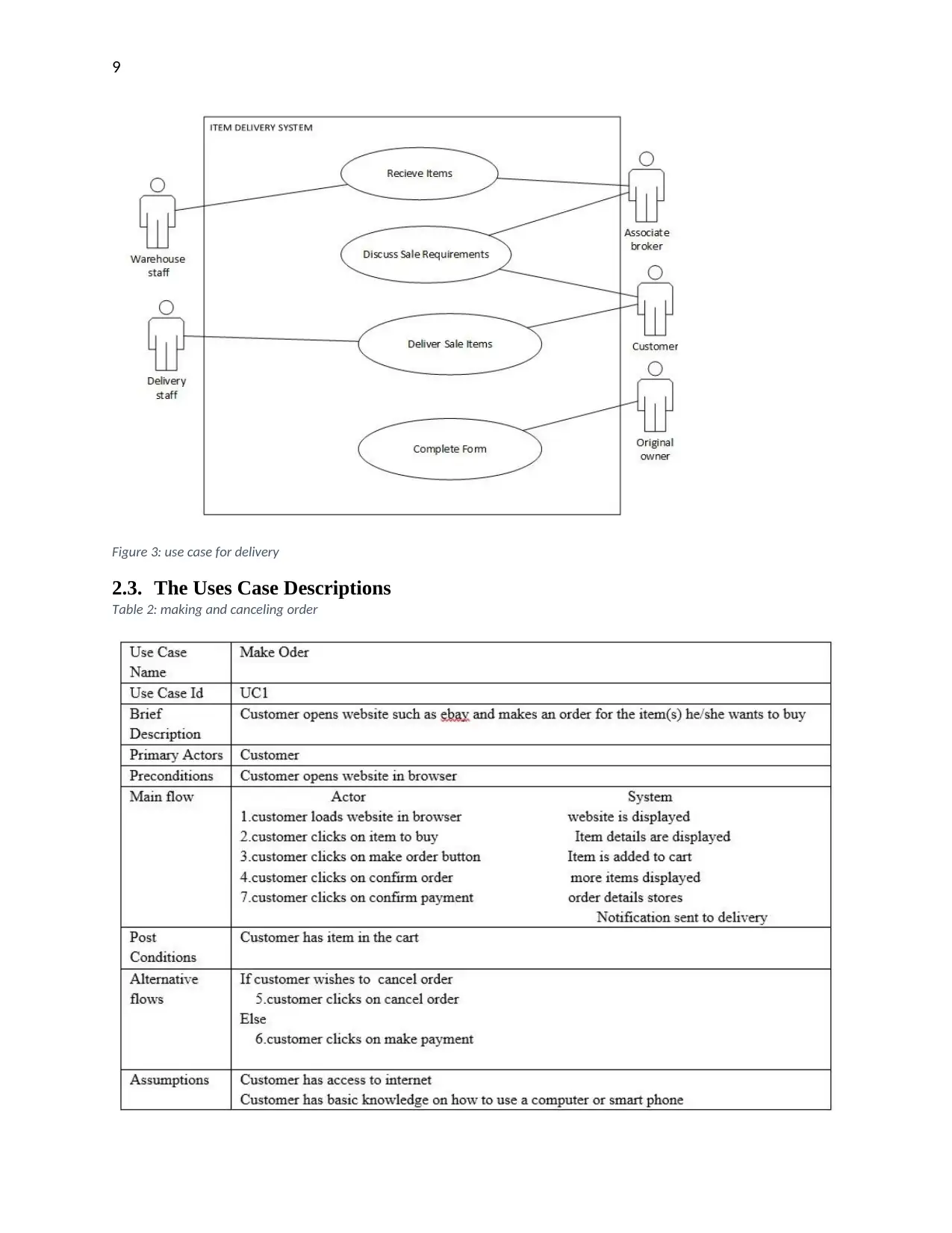
9
Figure 3: use case for delivery
2.3. The Uses Case Descriptions
Table 2: making and canceling order
Figure 3: use case for delivery
2.3. The Uses Case Descriptions
Table 2: making and canceling order
⊘ This is a preview!⊘
Do you want full access?
Subscribe today to unlock all pages.

Trusted by 1+ million students worldwide
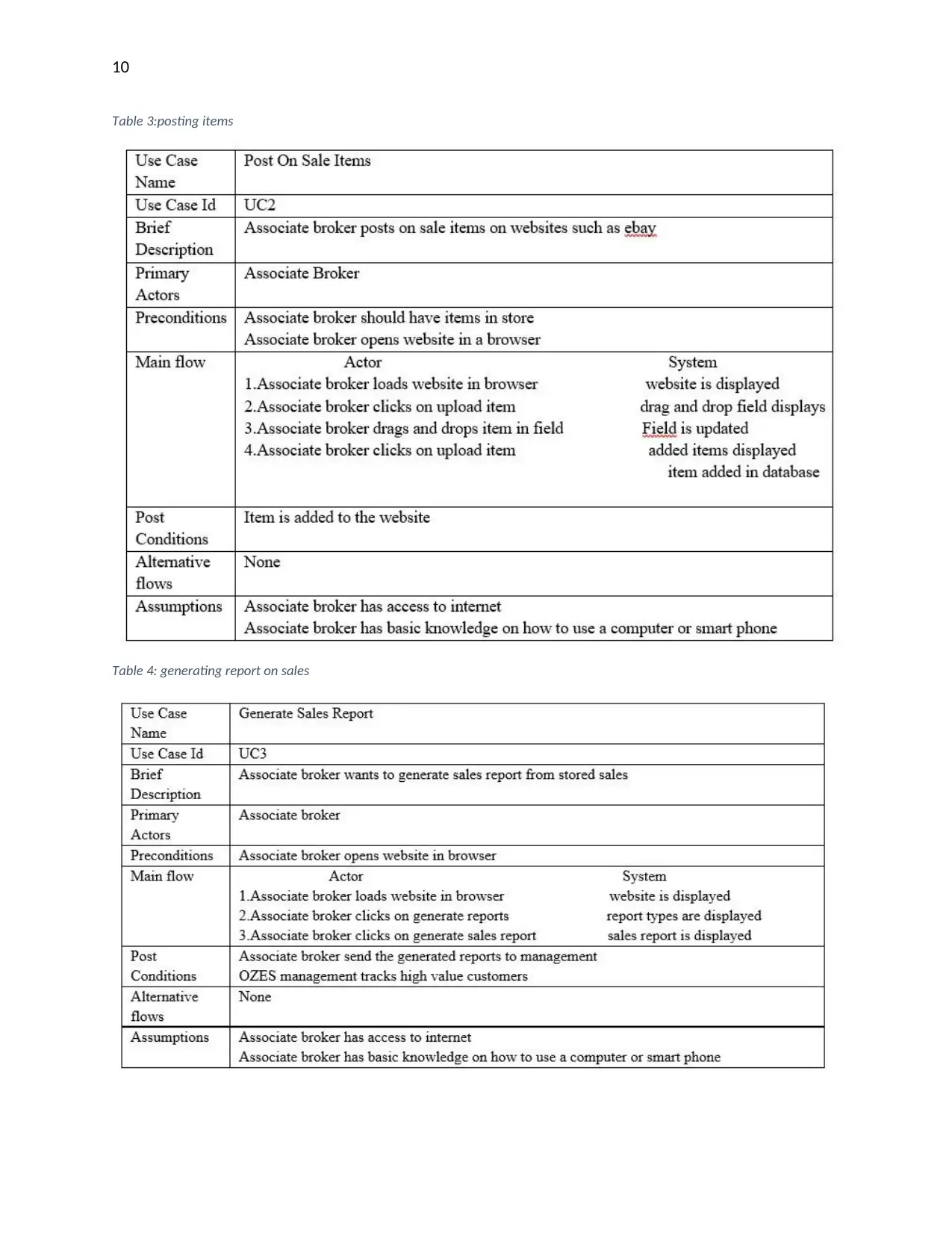
10
Table 3:posting items
Table 4: generating report on sales
Table 3:posting items
Table 4: generating report on sales
Paraphrase This Document
Need a fresh take? Get an instant paraphrase of this document with our AI Paraphraser
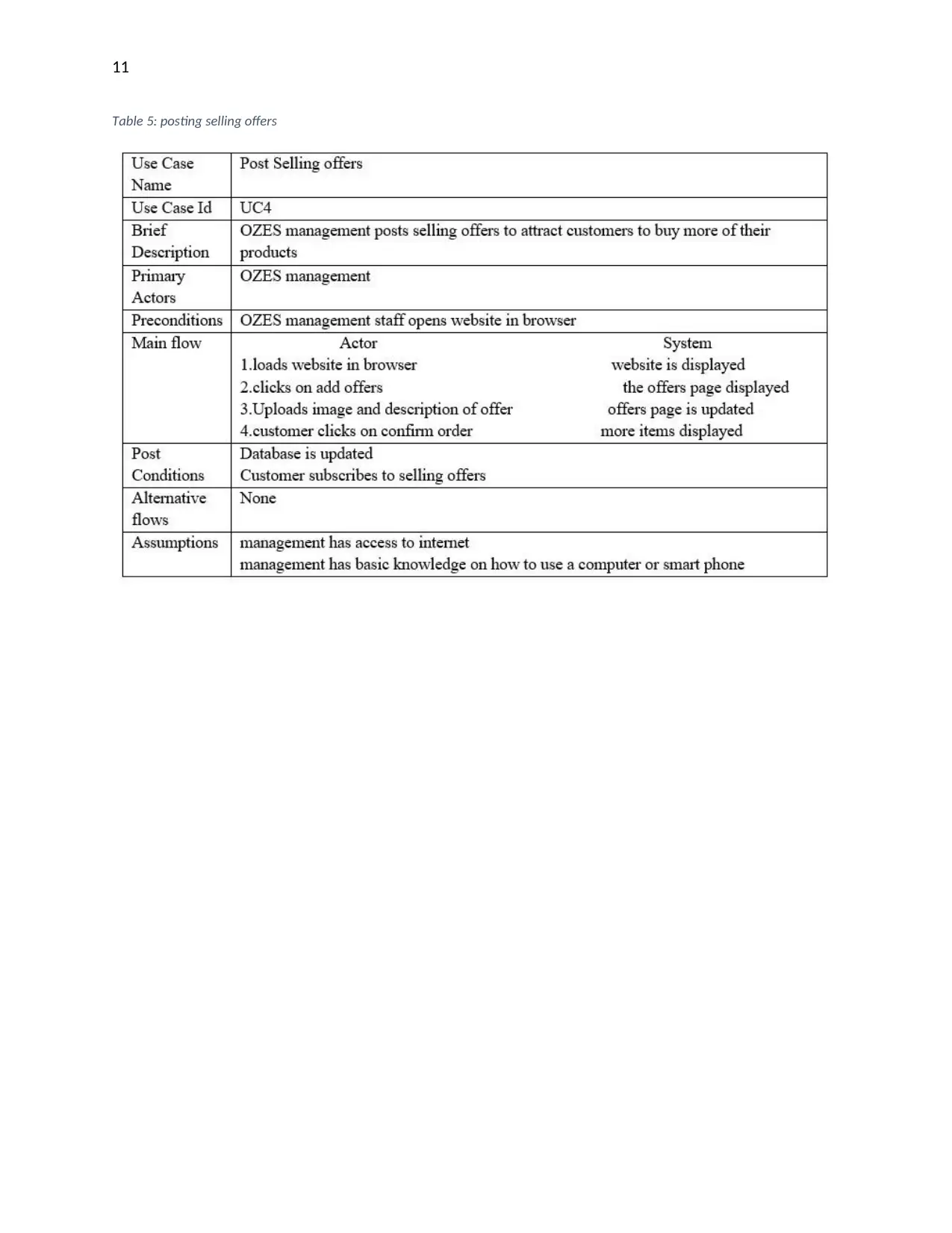
11
Table 5: posting selling offers
Table 5: posting selling offers
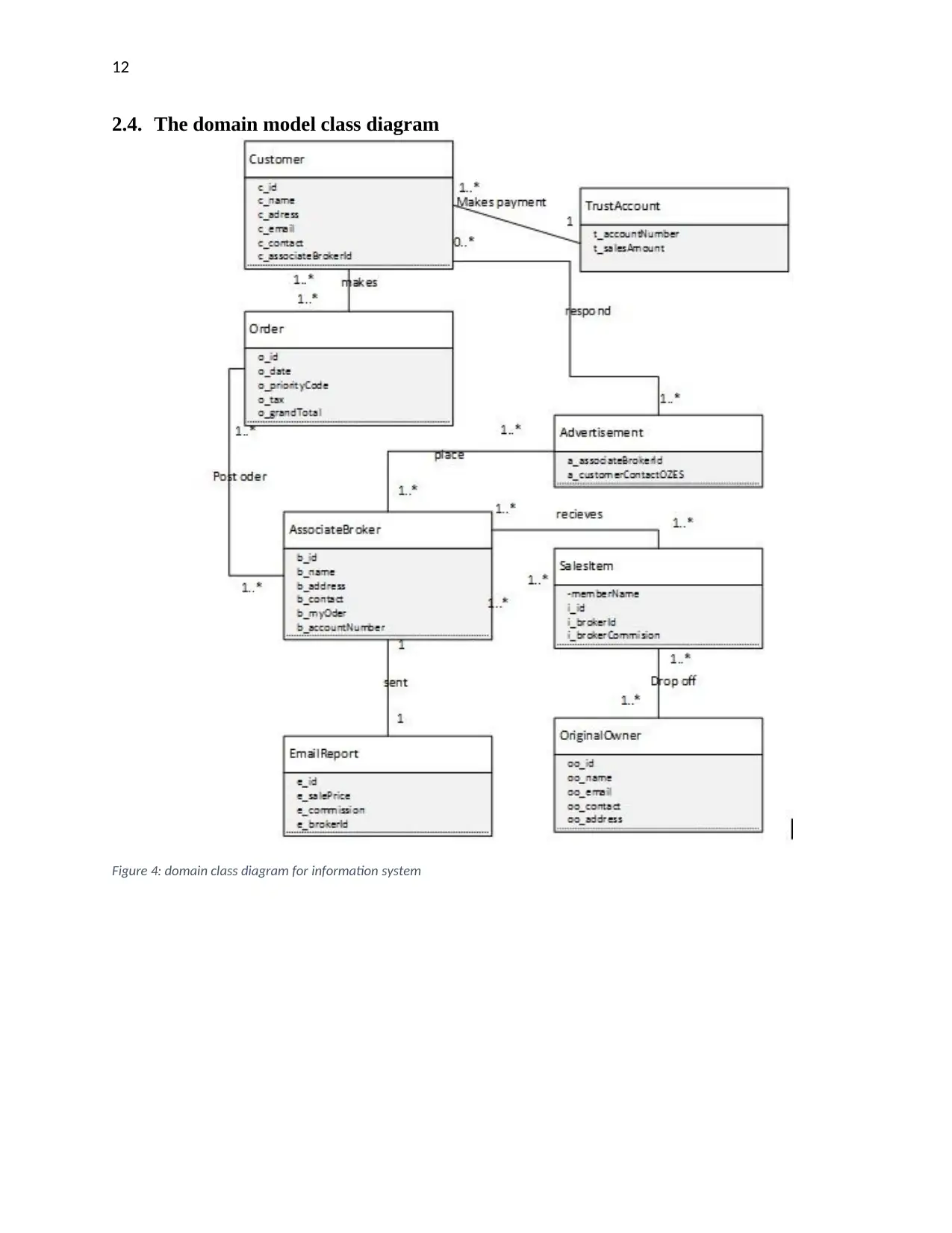
12
2.4. The domain model class diagram
Figure 4: domain class diagram for information system
2.4. The domain model class diagram
Figure 4: domain class diagram for information system
⊘ This is a preview!⊘
Do you want full access?
Subscribe today to unlock all pages.

Trusted by 1+ million students worldwide
1 out of 16
Related Documents
Your All-in-One AI-Powered Toolkit for Academic Success.
+13062052269
info@desklib.com
Available 24*7 on WhatsApp / Email
![[object Object]](/_next/static/media/star-bottom.7253800d.svg)
Unlock your academic potential
Copyright © 2020–2025 A2Z Services. All Rights Reserved. Developed and managed by ZUCOL.





